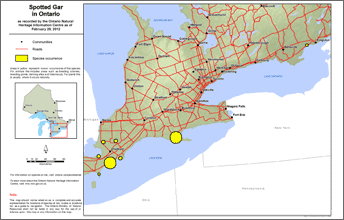Spotted gar
Scientific name: Lepisosteus oculatus

Cover photo credit: US Fish and Wildlife Service
Status
Endangered
“Endangered” means the species lives in the wild in Ontario but is facing imminent extinction or extirpation.
Date added to the Species at Risk in Ontario List
The Spotted Gar was already assessed as threatened when the Endangered Species Act took effect in 2008. It was reassessed as endangered in June 2016.
Read the assessment report (PDF)
What it looks like
The Spotted Gar has a long, streamlined body. In Ontario, it usually grows to a length of 50 centimetres, but has been known to reach more than 75 centimetres. It has a long beak-like mouth packed with sharp teeth. The body and head are olive or brownish-coloured and covered with dark spots. Its fins are also spotted and it has an olive-grey belly. The Spotted Gar is similar in appearance to the more common longnose gar, but its snout is much shorter and broader.
Where it lives
In Ontario, the Spotted Gar lives in calm, clear pools and bays with plenty of aquatic plants. It is usually found in lakes with soft mud bottoms. During the spring breeding season, the adults move to shallow water with lots of aquatic plants, where they mate and lay eggs. The eggs are slightly sticky and attach to aquatic plants. The Spotted Gar feeds on small fishes.
Where it’s been found in Ontario
In Canada, the Spotted Gar is found in a few wetlands along the north shore of Lake Erie and in East Lake off of eastern Lake Ontario. There are historic single records of this species from the Bay of Quinte and from Lake St. Clair at the mouth of the Thames River, but no recent sightings in these areas.
View a larger version of this map (PDF)
What threatens it
In Ontario, the small remaining populations of Spotted Gar are threatened by pollution and destruction of wetland habitat along the Lake Erie shoreline.
Action we are taking
Endangered Species and their general habitat are automatically protected.
Recovery Strategy
A recovery strategy advises the ministry on ways to ensure healthy numbers of the species return to Ontario.
Read the executive summary and full document (January 28, 2016).
Government response statement
A government response statement outlines the actions the government intends to take or support to help recover the species.
Read the government response statement (October 28, 2016)
Review of progress
A review of progress made toward protecting and recovering a species is required no later than the time specified in the species’ government response statement, or not later than five years after the government response statement is published if no time is specified.
Read the report on progress towards the protection and recovery of 18 species at risk, including Spotted Gar (2021).
Habitat protection
General habitat protection - June 30, 2013
What you can do
Report a sighting
- Report a sighting of an endangered animal or plant to the Natural Heritage Information Centre. Photographs with specific locations or mapping coordinates are always helpful.
Volunteer
- Volunteer with your local nature club or provincial park to participate in surveys or stewardship work focused on species at risk.
Be a good steward
- Private land owners have a very important role to play in species recovery. If you find a nesting on your land, you may be eligible for stewardship programs that support the protection and recovery of species at risk and their habitats.
- Invasive species seriously threaten many of Ontario’s species at risk. To learn what you can do to help reduce the threat of invasive species, visit: www.ontario.ca/invasivespecies ; www.invadingspecies.com ; www.ontarioinvasiveplants.ca ; and, www.invasivespecies.gc.ca.
- Help improve fish habitat and keep Ontario’s water safe and clean by maintaining natural vegetation next to lakes and rivers. There are many things that you can do to help keep pollution and soil from washing into Ontario’s lakes and rivers and you might be eligible for funding assistance. For more information, visit the Ontario Soil and Crop Improvement Association: www.ontariosoilcrop.org.
Report illegal activity
- Report any illegal activity related to plants and wildlife to
1-877-TIP-SMNR (847-7667) (847-7667).
Quick facts
- The Spotted Gar can breathe air! It uses a special organ called a swim bladder like a lung when the fish comes to the surface for a breath of air. This allows the fish to live in areas with little oxygen in the water. Like most fishes, the Spotted Gar also uses gills to breath underwater.
- Spotted Gar also use their swim bladders to maintain buoyancy allowing them to float like sticks near the surface of the water and drift toward their prey.
- The Spotted Gar is an ambush predator that lies in wait for prey. It can quickly lunge to capture prey using its streamlined body and long skinny snout. Its mouth is packed with sharp teeth for grabbing small fish, such as minnows and yellow perch, which are grabbed, flipped head first and swallowed.
- Young Spotted Gar eat mosquito larvae.
